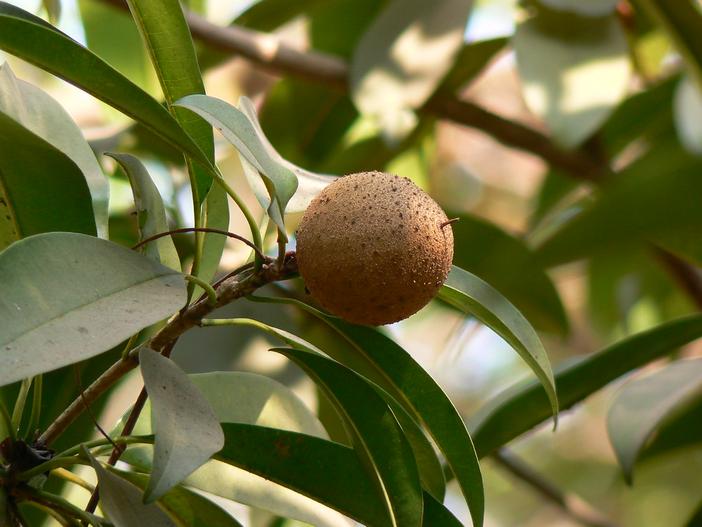Sapodilla
(Manilkara zapota)
Sapodilla (Manilkara zapota)
/
/

Dinesh Valke
CC BY-SA 2.0
Image By:
Dinesh Valke
Recorded By:
Copyright:
CC BY-SA 2.0
Copyright Notice:
Photo by: Dinesh Valke | License Type: CC BY-SA 2.0 | License URL: https://creativecommons.org/licenses/by-sa/2.0/ | Uploader: Dinesh Valke | Publisher: Flickr














































Estimated Native Range
Summary
Manilkara zapota, commonly known as Sapodilla, is an evergreen tree native to the rainforests and seasonally dry forests of Mexico, Central America, South America, and the Caribbean. It typically grows to a height of 30 meters (98 feet) with an average trunk diameter of 1.5 meters (5 feet). The tree is characterized by its wind resistance and the production of a white, gummy latex called chicle from its bark. Sapodilla has medium green, glossy, ornamental leaves and inconspicuous, bell-like white flowers with a six-lobed corolla. The fruit is a large berry, 4–8 cm (2–3 inches) in diameter, with flesh that ranges from pale yellow to earthy brown and a grainy texture similar to a well-ripened pear, featuring an exceptionally sweet, malty flavor.
Sapodilla is valued for its fruit and is also planted as an ornamental tree in tropical and subtropical gardens. It is known for its resilience to wind and is sometimes used as a windbreak. The tree’s deep root system allows it to withstand periods of drought, making it relatively easy to maintain. In cultivation, Sapodilla thrives in full sun to part shade and can adapt to a range of soil types, provided they offer good drainage. While it is not particular about soil pH, it does best in soils that are moderately fertile. It is important to note that Sapodilla can become invasive in some regions, such as Florida, and should be planted with caution outside its native range.CC BY-SA 4.0
Sapodilla is valued for its fruit and is also planted as an ornamental tree in tropical and subtropical gardens. It is known for its resilience to wind and is sometimes used as a windbreak. The tree’s deep root system allows it to withstand periods of drought, making it relatively easy to maintain. In cultivation, Sapodilla thrives in full sun to part shade and can adapt to a range of soil types, provided they offer good drainage. While it is not particular about soil pH, it does best in soils that are moderately fertile. It is important to note that Sapodilla can become invasive in some regions, such as Florida, and should be planted with caution outside its native range.CC BY-SA 4.0
Plant Description
- Plant Type: Tree
- Height: 30-60 feet
- Width: 20-40 feet
- Growth Rate: Slow
- Flower Color: N/A
- Flowering Season: Spring
- Leaf Retention: Evergreen
Growth Requirements
- Sun: Full Sun, Part Shade
- Water: Medium
- Drainage: Fast, Medium, Slow
Common Uses
Drought Tolerant, Edible*Disclaimer: Easyscape's listed plant edibility is for informational use. Always verify the safety and proper identification of any plant before consumption., Hedges, Low Maintenance, Salt Tolerant
Natural Habitat
native to the rainforests and seasonally dry forests of Mexico, Central America, South America, and the Caribbean
Other Names
Common Names: Sapota, Chikoo, Chico, Naseberry, Nispero, Sapote, Chicle, Naseberry, Breiapfelbaum, Sapodillbaum
Scientific Names: , Achras sapota, Manilkara zapota, Manilkara sapota, Manilkara achras, Calocarpum mammosum, Achras zapota, Pouteria mammosa, Manilkara zapotilla, Lucuma mammosa
GBIF Accepted Name: Manilkara zapota (L.) P.Royen